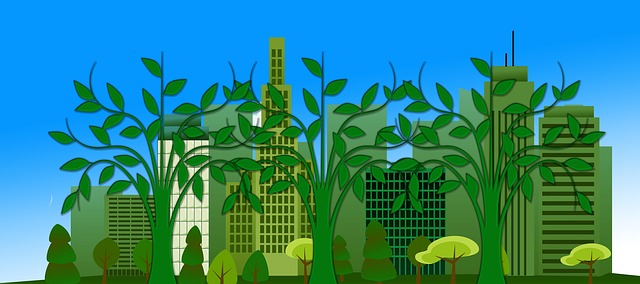‘Eco-city’ is an umbrella term that covers various notions of, and approaches to, sustainable urbanism, rather than a conceptually coherent and practically uniform phenomenon––sister terms include ‘climate-neutral city’, ‘low-carbon city’, ‘smart city’, ‘sustainable city’, ‘transition towns’, among others..”
(Joss 2012:5)
Eco-city is a new buzzword in Environmentalism. It is an over-arching term which covers anything from Solar Villages to Cohousing. Broadly speaking, Eco-city refers to a self-sustaining environment and ecosystem. However, there are certainly some qualifications for a Green-Initiative to be counted as an Eco-city. They include:
1. A golden mean between Economy, Environment and Social dimensions
An eco-city keeps balance between Profit, People and Planet.
2. Scale: It should be undertaken at a large scale to provide sustainable living for at least a few thousand families.
Eco-cities can be established either by transitioning to Alternative energy resources in an existing set up or they can be built from scratch using Environment friendly technologies.
(If you want to learn more about Eco-cities, read: How Can We Make Our Cities Sustainable (An Eco-City)?)
Examples of Sustainable cities or Eco-cities
Oslo, Norway
Oslo is the most sustainable city in terms of Green Energy. Norway is transitioning to renewable energy with leaps and bounds. In fact 80% of the automobiles sold in Norway were electric. The country has effectively employed Rainwater Harvesting Techniques to effectively manage stormwater. In 2019, Oslo was given the European Green Capital Award owing to its green transition efforts to tackle climate change.
Sino-Singapore Tianjin Eco-city
It is a joint-initiative of the governments of China and Singapore, seeking to provide housing for 3.5 lac residents, on an erstwhile industrial waste dumping site. Its vision and mission are explained in terms of Three Harmonies and Three Abilities. Three Harmonies include Social harmony, Economic vibrancy and Environmental sustainability. Whereas, Three Abilities include Practicality, Replicability and Scalability. The concept of Tianjin Eco-city project is unique as it is built on a waste-dumping site contrary to all others which are established on ecologically important sites. If successful, Tianjin Eco-city can be a game changer in reclaiming ecologically poor sites.
Characteristics of an Eco-city or sustainable city
• Sustainable energy systems
An eco-city is roughly self-sufficient in Energy supply. Energy harvesting is sought by renewable energy from sun, wind or water or Bio-fueled combined Heat Power system. Passive solar technologies are also part and parcel of the Eco-cities.
• Sustainable waste management
Waste is the most damaging aspect of environmental degradation. Eco-cities employ smart waste collection and disposal mechanisms to minimize waste. Eco-city projects have Smart waste collecting system, Vacuum waste chute system, and Food waste disposers. They encourage technologies aimed at reducing and recycling waste. Moreover, eco-cities also have wastewater and sewage treatment systems to keep natural water reservoirs clean from industrial effluents.
• High performance infrastructure
Eco-city infrastructure is highly optimized and well-integrated to ensure maximum resource utilization in a sustainable manner. It involves Component and multifunctional optimization and integrated design.
Also check out: 10 Easy Ways To Store And Use Rainwater In Your House
• High performance buildings
Buildings are designed keeping in mind energy sustainability. Energy efficiency technology is used to reduce energy demand and renewable energy resources are undertaken to produce energy sustainably. Pollution prevention is sought at all stages to ensure zero or near zero waste generation.
• Sustainable transportation
Transportation produces nearly 27% of all Greenhouse gas emissions. Therefore, sustainable cities undertake sustainable transportation technologies. Mass transportation by metro, tram etc is widely implemented. Citizens are encouraged to walk or use pollution-free means such as cycles, electric cars etc.
• Ecological diversity and Green factor
Eco-cities have a greater Green factor i.e. ratio of green area to total area of a city. Urban forestry, xeriscaping, and vertical farming are some of the most widely used techniques. Green factor planning tools are used to keep an account of green belts.
Also check out: Rooftop Vegetation and Vertical Gardening – Solution to Self-Sustenance
Conclusion
Eco-cities are a profitable and foolproof solution to climate change as they minimize greenhouse emissions and use environment friendly technologies. Environment-conscious decisions are taken from planning to resource allocation to implementation and businesses are encouraged to design economic policies that are socially and environmentally sound.
References
ecocitybuilders.org/
energyinformatics.springeropen.com
This article is written by: Tooba S.
She is a Technical Content Writer with an interest in Environment and Sustainable development.
We hope you liked this post! Please comment below if you have any suggestions, comments or feedback! We at #envpk love hearing from readers! Thanks.




